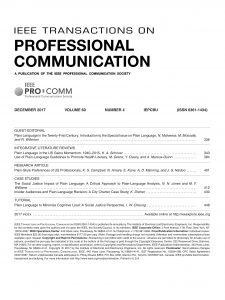4Q17 Special Issue of IEEE Transactions on Professional Communication on Plain Language
Published on November 26, 2017
 The December 2017 special issue of the IEEE Transactions on Professional Communication on plain language has recently been published online. If you are a paper subscriber, you will receive the issue, printed together with the September issue, during the next month.
The December 2017 special issue of the IEEE Transactions on Professional Communication on plain language has recently been published online. If you are a paper subscriber, you will receive the issue, printed together with the September issue, during the next month.
Volume 60, Number 4, December 2017
Guest Editorial— Plain Language in the Twenty-First Century: Introduction to the Special Issue on Plain Language, by N. Matveeva, M. Moosally, and R. Willerton
After establishing the context of plain language within technical communication, we consider the service ethic of the plain-language movement and then review some recent research and publications on plain language in the fields of law and of technical and professional communication. Finally, we preview the articles in this special issue.
Integrative Literature Review—Plain Language in the United States Gains Momentum: 1940–2015, by K. Schriver
Between 1940 and 1970, plain language focused mainly on readability. During the 1970s, some practitioners began to employ usability testing. By the mid-1980s, there was a widespread sense that priorities had shifted from readability to usability. Between 1980 and 2000, advocates broadened their vision—beyond word- and sentence-level concerns to include discourse-level issues, information design, and accessibility. Between 2000 and 2015, advocates continued to worry over their old questions (“Can people understand and use the content?”), but also asked, “Will people believe the content? Do they trust the message?” By 2015, plain language had gained significant momentum in business, government, medicine, and education.
Integrative Literature Review—Use of Plain Language Guidelines to Promote Health Literacy: A Systematic Literature Review, by M. Grene, Y. Cleary, and A. Marcus-Quinn
This article presents the findings from a review of research into the use of plain language to promote health literacy. We describe our selection process and characterize the corpus of articles along four dimensions: objectives, methodology, plain-language guidelines used, and findings. Analysis of 13 articles that explored the use of plain-language guidelines in health literacy promotion demonstrates that plain-language guidelines could play a strategic role in educating patients. Use of plain language could help healthcare practitioners to communicate critical and sometimes very complex health information effectively.
Research Article—Plain Style Preferences of U.S. Professionals, by K. S. Campbell, N. Amare, E. Kane, A. D. Manning, J. S. Naidoo
We conducted a quantitative study of preferences for two major style categories (conciseness and word choice) using an online survey instrument with usable responses from 614 working adults in the United States. Using that data, we calculated proportions of respondents who chose the plain style options. We also explored associations between preferences and respondent characteristics. Our findings support an overwhelming preference for plain style among U.S. professionals who are native speakers of English. Reader preferences were stronger for elements associated with word choice than with conciseness. Those with lower education levels and blue-collar occupations had lower preferences for plain style.
Case Study— The Social Justice Impact of Plain Language: A Critical Approach to Plain Language Analysis, by N. N. Jones, M. F. Williams
This study investigates how plain language is implemented in mortgage documents and what the implications are for African-American homebuyers. We focused on the initial disclosure statements for adjustable-rate mortgages, pairing critical discourse analysis with the Securities and Exchange Commission’s guidelines to analyze three disclosure statements. We found that, generally speaking, each of the statements effectively adhered to plain-language recommendations. However, the idea that plain language increases accessibility, reader comprehension, and usability is complicated, and the accessibility and usability of each document varied.
Case Study—Insider Audiences and Plain-Language Revision: A City Charter Case Study, by K. Dreher
This study investigates the effects of plain-language revision on insider audiences following the adoption of a revised city charter in a Midwestern US city. Plain language is associated with helping public or vulnerable audiences to access complex information. This core priority toward public or non-expert audiences is important; however, it has also resulted in a limited understanding of the full scope of plain-language audiences, especially in contexts where insider and expert audiences are primary users. This article, informed by genre theory, is a qualitative case study in which textual artifacts and interview data were collected and analyzed. The analysis showed many effects, nearly all positive, for insiders and experts.
Tutorial— Plain Language to Minimize Cognitive Load: A Social Justice Perspective, by I. W. Cheung
This tutorial explores ethical implications of cognitive load theory and intersectional theory on technical and professional communication and proposes plain language as an ethical imperative to redress social inequities. When the cognitive load of a learning task is too high and overwhelms working memory, learning is impaired. The greater stress and mental burden that marginalized populations experience can leave less working memory available for reading and learning. Using plain language to reduce cognitive load can be considered a political act that increases marginalized populations’ opportunities to understand.
The issue is available online at: http://ieeexplore.ieee.org/xpl/RecentIssue.jsp?punumber=47. Note that a user ID and password are required to view individual articles.
SaveSave
SaveSave

